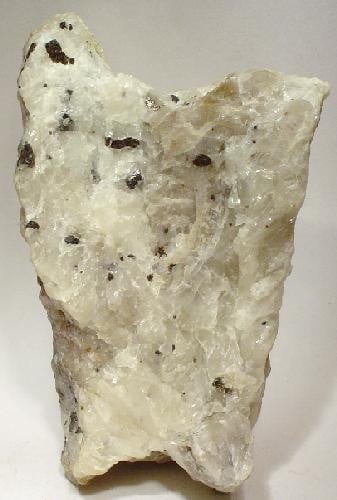Wollastonite Value, Price, and Jewelry Information
Interesting cabochons have been cut from wollastonite, especially from the fibrous material (which yields catseye stones) and the reddish material from Lake Superior’s lsle Royale. Wollastonite is strictly a curiosity and as a mineral is not especially rare. It resembles other white fibrous minerals, however, and is sometimes difficult to identify without using X—ray techniques. Facetable wollastonite is exceedingly rare, the material from Asbestos, Quebec (Jeffrey Mine) being singularly notable. Such gems are, moreover, extremely difficult to cut because of the cleavage and fibrosity of the mineral.
Interesting cabochons have been cut from wollastonite, especially from the fibrous material (which yields catseye stones) and the reddish material from Lake Superior’s lsle Royale. Wollastonite is strictly a curiosity and as a mineral is not especially rare. It resembles other white fibrous minerals, however, and is sometimes difficult to identify without using X—ray techniques. Facetable wollastonite is exceedingly rare, the material from Asbestos, Quebec (Jeffrey Mine) being singularly notable. Such gems are, moreover, extremely difficult to cut because of the cleavage and fibrosity of the mineral.
Start an IGS Membership today
for full access to our price guide (updated monthly).Wollastonite Value
Optics:a =1.616-1.640; β= 1.628-1.650; γ: 1.631-1.653.
Biaxial (-), 2V: 38-60°.
Shadow edge in refractometer about 1.63.
Occurrence: Metamorphosed limestones and alkalic igneous rocks.
California (various localities); Willsboro, New York; Alaska: Pennsylvania; New Mexico.
Ontario and Quebec, Canada; Chiapas, Mexico; Norway:
Italy; Rumania; Finland.
Isle Royale, Lake Superior: compact, pale red material, good for cutting cabochons.
Comments: Interesting cabochons have been cut from wollastonite, especially from the fibrous material (which yields catseye stones) and the reddish material from Lake Superior's lsle Royale. Wollastonite is strictly a curiosity and as a mineral is not especially rare. It resembles other white fibrous minerals, however, and is sometimes difficult to identify without using X—ray techniques. Facetable wollastonite is exceedingly rare, the material from Asbestos, Quebec (Jeffrey Mine) being singularly notable. Such gems are, moreover, extremely difficult to cut because of the cleavage and fibrosity of the mineral.
Name: After W. H. Wollaston, British mineralogist and chemist.
Joel E. Arem, Ph.D., FGA
Dr. Joel E. Arem has more than 60 years of experience in the world of gems and minerals. After obtaining his Ph.D. in Mineralogy from Harvard University, he has published numerous books that are still among the most widely used references and guidebooks on crystals, gems and minerals in the world.
Co-founder and President of numerous organizations, Dr. Arem has enjoyed a lifelong career in mineralogy and gemology. He has been a Smithsonian scientist and Curator, a consultant to many well-known companies and institutions, and a prolific author and speaker. Although his main activities have been as a gem cutter and dealer, his focus has always been education. joelarem.com
Related Articles
Black Diamond Value, Price, and Jewelry Information
Chameleon Diamond Value, Price, and Jewelry Information
Gray Diamond Value, Price, and Jewelry Information
Green Diamond Value, Price, and Jewelry Information
Latest Articles
Quartz Toxicity: Understanding the Risks for Jewelers and Wearers
Synthetic Amethyst: What is it and How is it Made?
Hambergite Value, Price, and Jewelry Information
Pearl Simulants: How to Spot Faux Pearls
Never Stop Learning
When you join the IGS community, you get trusted diamond & gemstone information when you need it.
Get Gemology Insights
Get started with the International Gem Society’s free guide to gemstone identification. Join our weekly newsletter & get a free copy of the Gem ID Checklist!
